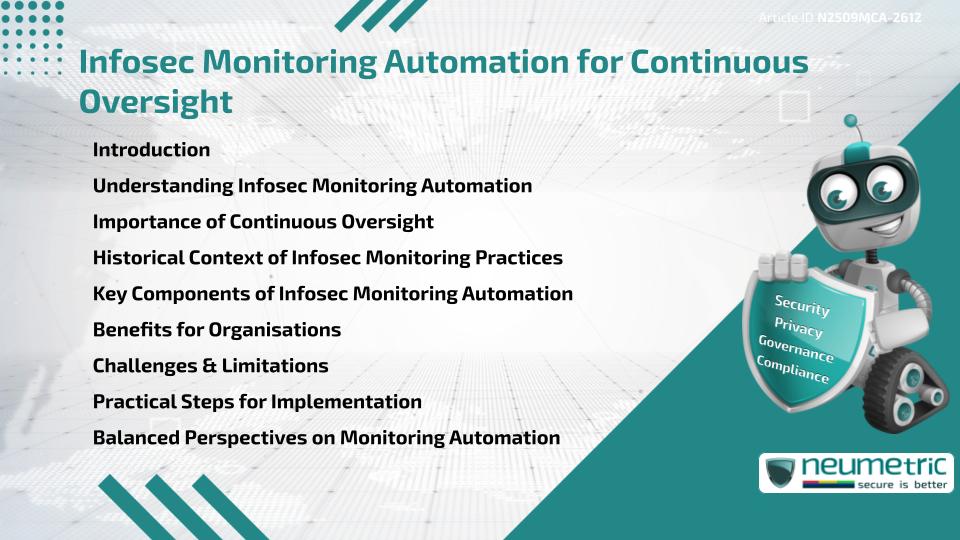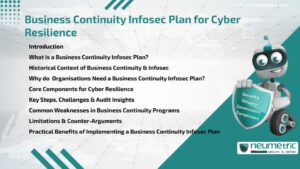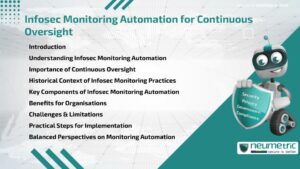Table of Contents
ToggleIntroduction
Infosec Monitoring Automation has become essential for Organisations seeking Continuous Oversight of their digital environments. By automating the monitoring of Systems, Networks & Applications, enterprises can detect Threats, enforce Compliance & manage Risks more efficiently. Continuous oversight powered by automation ensures that Security is not a one-time activity but an ongoing process. This approach strengthens defenses, enhances Resilience & reduces the Likelihood of human oversight failures in critical Information Security operations.
Understanding Infosec Monitoring Automation
Infosec Monitoring Automation refers to the use of tools, scripts & platforms that continuously track Security Events, Anomalies & Policy Violations. Instead of relying solely on manual monitoring, automation introduces speed & consistency. For example, automated log analysis tools can detect suspicious login attempts within seconds, where manual monitoring might take hours or days. This allows Organisations to act quickly & limit potential damage.
Importance of Continuous Oversight
Continuous oversight ensures that Security Measures remain effective even as Threats evolve. Unlike periodic Assessments, Automated monitoring works around the clock. It provides real-time visibility into Systems & helps identify Risks before they escalate. Much like a medical monitoring device tracks a patient’s health 24/7, Infosec Monitoring Automation safeguards the digital health of an enterprise.
Historical Context of Infosec Monitoring Practices
Early Information Security Monitoring relied heavily on manual reviews of logs & system alerts. While effective for smaller systems, manual methods became unsustainable as networks expanded & Threats grew more complex. The rise of Security Information & Event Management [SIEM] systems in the early 2000s was a turning point, enabling automated data collection & alerting. Today, Infosec Monitoring Automation builds upon that foundation by adding Artificial Intelligence, Machine Learning & advanced Analytics to deliver even more proactive oversight.
Key Components of Infosec Monitoring Automation
Effective Infosec Monitoring Automation includes several components:
- Data Collection: Gathering logs, events & telemetry across Endpoints, Servers & Networks.
- Correlation & Analysis: Using rules or machine learning to identify Suspicious Patterns.
- Alerting & Notification: Automatically triggering alerts when anomalies are detected.
- Response Automation: Executing predefined actions such as blocking IP addresses or isolating Endpoints.
- Reporting & Compliance: Generating automated reports for Audits & Regulatory requirements.
Together, these components form a robust system that ensures both proactive detection & responsive action.
Benefits for Organisations
Adopting Infosec Monitoring Automation provides several advantages:
- Faster detection & response to Threats
- Reduced reliance on manual processes & human error
- Improved Compliance with Security regulations
- Cost savings through Efficiency & reduced Incident impact
- Enhanced visibility across complex infrastructures
Much like automated Financial auditing tools improve accuracy & save time, monitoring automation delivers consistency & reliability to security operations.
Challenges & Limitations
Despite its benefits, Infosec Monitoring Automation presents certain challenges:
- High initial investment in tools & infrastructure
- Complexity in configuring automation to avoid false positives
- Risk of over-reliance on automation without human oversight
- Need for skilled professionals to manage & optimise systems
These challenges highlight the importance of balancing automation with human expertise & Continuous Improvement.
Practical Steps for Implementation
Organisations can adopt Infosec Monitoring Automation through the following steps:
- Assess current monitoring capabilities & identify Gaps
- Select appropriate automation tools that align with business needs
- Define clear rules & response actions for automated systems
- Train teams to interpret automated alerts & act effectively
- Continuously review & update automation processes to adapt to evolving Threats
This approach mirrors safety automation in industrial plants, where machines handle repetitive tasks but humans provide critical oversight.
Balanced Perspectives on Monitoring Automation
Some experts argue that Infosec Monitoring Automation could lead to complacency if Organisations rely too heavily on automated systems. Others see it as indispensable given the scale & speed of modern Cyber Threats. The most balanced approach combines automation with skilled professionals who interpret insights, refine processes & maintain Accountability. This ensures that automation strengthens rather than replaces human decision-making in Security Management.
Takeaways
- Infosec Monitoring Automation provides Continuous Oversight for digital environments.
- It enhances speed, consistency & accuracy in Threat detection.
- Key components include data collection, analysis, alerting & response automation.
- Benefits include improved Compliance, Cost savings & Resilience.
- Organisations must balance automation with human expertise to address limitations.
FAQ
What is Infosec Monitoring Automation?
It is the use of automated tools & systems to continuously track, analyse & respond to Information Security events.
Why is Continuous Oversight important?
Continuous oversight ensures that Security Measures remain effective, providing real-time visibility into Threats & Risks.
What are the main components of monitoring automation?
They include data collection, correlation, alerting, automated response & reporting.
Is Infosec Monitoring Automation expensive to implement?
Initial costs can be high, but long-term savings from efficiency & reduced breaches often outweigh expenses.
Can automation replace human security teams?
No, automation complements human expertise by handling repetitive tasks while professionals manage strategy & decision-making.
What challenges are associated with automation?
Challenges include configuration complexity, false positives & Risk of over-reliance on technology.
How can Organisations get started?
By assessing current monitoring practices, selecting tools, defining rules & integrating automation gradually into their workflows.
Does monitoring automation help with Compliance?
Yes, it generates reports & provides Audit-ready Evidence, supporting adherence to regulations & Industry Standards.
Need help for Security, Privacy, Governance & VAPT?
Neumetric provides organisations the necessary help to achieve their Cybersecurity, Compliance, Governance, Privacy, Certifications & Pentesting needs.
Organisations & Businesses, specifically those which provide SaaS & AI Solutions in the Fintech, BFSI & other regulated sectors, usually need a Cybersecurity Partner for meeting & maintaining the ongoing Security & Privacy needs & requirements of their Enterprise Clients & Privacy conscious Customers.
SOC 2, ISO 27001, ISO 42001, NIST, HIPAA, HECVAT, EU GDPR are some of the Frameworks that are served by Fusion – a SaaS, multimodular, multitenant, centralised, automated, Cybersecurity & Compliance Management system.
Neumetric also provides Expert Services for technical security which covers VAPT for Web Applications, APIs, iOS & Android Mobile Apps, Security Testing for AWS & other Cloud Environments & Cloud Infrastructure & other similar scopes.
Reach out to us by Email or filling out the Contact Form…





